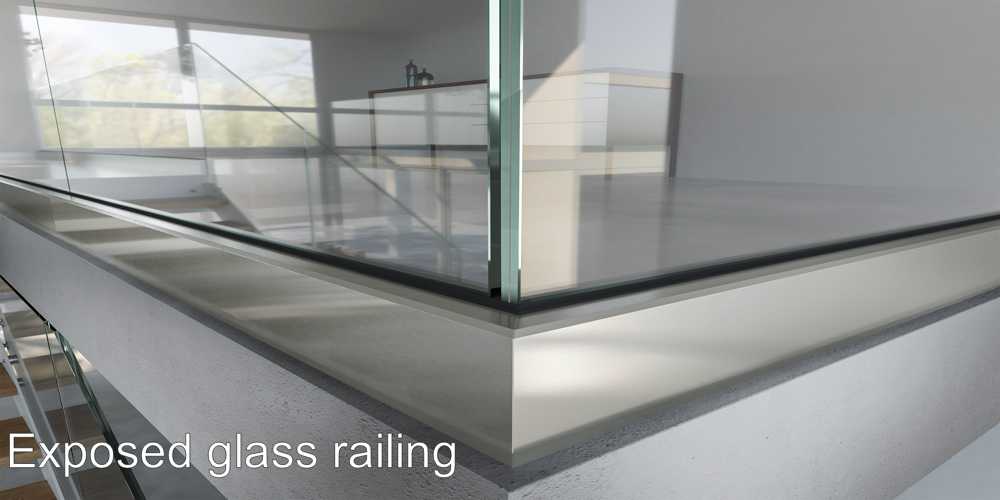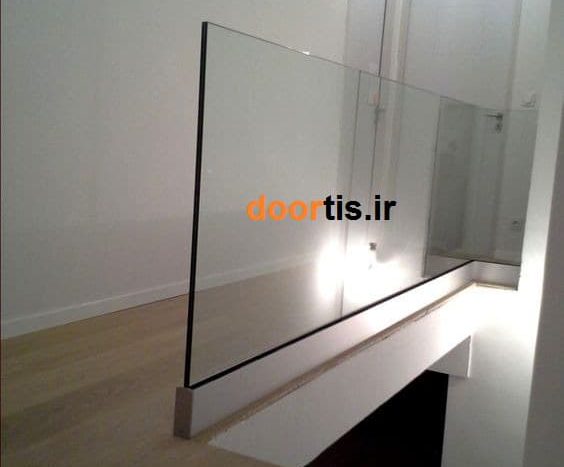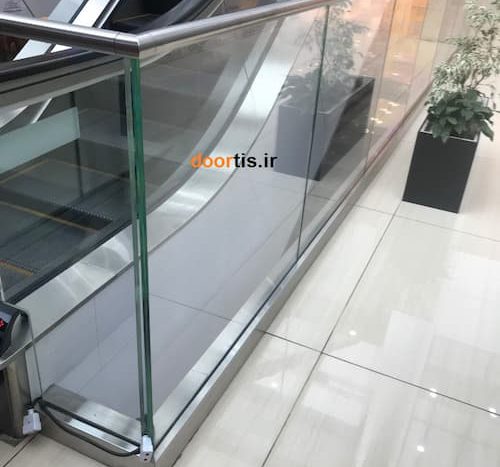Glass railing with an exposed base نرده شیشه ای اکسپوز refers to a type of glass railing system where the base or bottom support of the railing is visible, rather than being concealed within a channel or hidden from view. This design style can add a unique touch to the overall look of the railing and can be used to match the aesthetic of the surrounding area. The exposed base of the railing can be made of materials such as metal, wood, or stone to match the desired look and feel. Glass railings with exposed bases are often used in modern or contemporary design to create a sleek and minimalistic look.
![]()

· Overview of Exposed Glass Railing: A brief introduction to the concept of exposed glass railing, including its design and style options.
Exposed glass railing refers to a type of railing system that is characterized by its use of tempered glass panels that are supported by metal or other types of framing. The glass panels are typically suspended from metal posts, spigots, or other types of mounting hardware, allowing them to be securely and safely attached to the surface.
Exposed glass railing is designed to provide an unobstructed view while also offering a modern and stylish appearance. It is commonly used in residential and commercial settings, including balconies, terraces, staircases, and other areas where a railing is required.
In terms of design and style options, exposed glass railing is highly customizable, with a wide range of options available to suit different preferences and architectural styles. For example, there are different types of glass panels available, including clear, frosted, or tinted glass, as well as various metal finishes, such as brushed stainless steel, matte black, and more. Additionally, the metal frames can be designed in a variety of shapes and styles to suit different needs and aesthetics.
Overall, exposed glass railing provides a modern and stylish solution for those looking to add a touch of elegance to their spaces while also ensuring safety and security.

· Materials Used in Exposed Glass Railing: A discussion of the materials used in exposed glass railing, including the types of glass and metal commonly used.
Exposed glass railing systems typically use tempered glass panels and metal or other materials for the frame and mounting hardware.
The glass panels used in exposed glass railing systems are usually made of tempered glass, which is a type of safety glass that is designed to shatter into small, rounded pieces if broken. This helps to reduce the risk of injury in case of breakage. In addition to tempered glass, other types of glass can also be used, such as laminated glass or tinted glass.
The metal used in exposed glass railing systems is typically made of stainless steel, aluminum, or other corrosion-resistant materials. Stainless steel is a popular choice for its durability and resistance to rust and corrosion, making it an ideal choice for outdoor or coastal environments. Aluminum is a lighter option that can be anodized or powder-coated to match the desired finish. Other materials, such as wood or PVC, can also be used for the frames or mounting hardware.
In terms of metal finishes, exposed glass railing systems are available in a variety of finishes, including brushed stainless steel, matte black, and other colors and textures. These finishes can be selected to complement the architectural style of the building and to match the desired aesthetic.
Overall, the materials used in exposed glass railing systems are chosen for their durability, resistance to weathering and corrosion, and aesthetic appeal.

· Installation Process for Exposed Glass Railing: A step-by-step guide to the installation process for exposed glass railing, including preparation, measurement, and assembly.
The installation process for exposed glass railing typically involves the following steps:
- Preparation: This involves marking out the area where the railing will be installed, including the placement of posts and other mounting hardware. Any necessary permits or approvals should also be obtained before installation begins.
- Measurement: Accurate measurements of the area where the railing will be installed are taken to ensure the correct size of glass panels and metal frames.
- Assembly: The metal frames and mounting hardware are assembled according to the manufacturer's instructions, and the glass panels are then secured in place using special fasteners or clamps.
- Installation of Posts and Mounting Hardware: The metal posts and mounting hardware are attached to the surface using bolts or other types of fasteners, and the assembled metal frames are then attached to the posts.
- Glass Panel Installation: The tempered glass panels are then inserted into the metal frames, and any necessary seals or gaskets are applied to prevent water or air infiltration.
- Finishing: The final step involves any necessary touch-ups or cleanup, including the removal of any protective film or coverings from the glass panels.
It is important to note that installation of exposed glass railing systems should only be performed by professionals who are trained and experienced in this type of work. Improper installation can result in safety hazards and other issues.
Overall, the installation process for exposed glass railing is a complex and detailed process that requires precise measurements, accurate assembly, and professional installation to ensure a safe and secure railing system.

· Advantages of Using Exposed Glass Railing: A review of the benefits of using exposed glass railing, including its aesthetic appeal, durability, and safety features.
Exposed glass railing has several advantages, including:
- Aesthetic appeal: Exposed glass railing provides a modern and stylish appearance that can enhance the look of any space. The clear glass panels allow for unobstructed views, making them ideal for balconies, terraces, and other areas with a view.
- Durability: Exposed glass railing is made of high-quality materials, including tempered glass and corrosion-resistant metal, making it highly durable and resistant to weathering and wear over time.
- Safety: The use of tempered glass in exposed glass railing systems provides a high level of safety, as the glass is designed to shatter into small, rounded pieces if broken, reducing the risk of injury.
- Low maintenance: Exposed glass railing is relatively low maintenance, requiring only occasional cleaning to keep it looking its best.
- Customizable: Exposed glass railing is highly customizable, with a wide range of options available in terms of glass panels, metal finishes, and frame designs, allowing for a unique and personalized look.
Overall, exposed glass railing provides a modern and stylish solution that offers a high level of durability and safety while being low maintenance and customizable. It is a popular choice for those looking to enhance the appearance and safety of their spaces.

· Maintenance and Care for Exposed Glass Railing: Tips and best practices for maintaining and caring for exposed glass railing, including cleaning and maintenance procedures.
To maintain the appearance and functionality of exposed glass railing, it is important to follow these tips and best practices:
- Cleaning: Regular cleaning of the glass panels is important to remove any dirt or grime that can accumulate over time. Use a mild soap solution and a soft cloth to clean the glass, avoiding the use of abrasive cleaners or tools that can scratch the surface.
- Protect from scratches: To avoid scratches, avoid placing heavy or sharp objects on the glass panels and be mindful of any other activities that could potentially scratch the surface.
- Protect from weather: Exposure to extreme weather conditions can cause damage to the metal frames and glass panels. To minimize damage, it is important to keep the railing free from accumulated debris and to cover it during periods of heavy rain or snow.
- Check for damage: Regularly inspect the railing for any signs of damage or wear, such as loose bolts, cracks in the glass, or rust on the metal frames. If damage is detected, it is important to have it repaired promptly to prevent further damage or safety hazards.
- Proper storage: If the railing needs to be removed for any reason, such as for cleaning or maintenance, it is important to store it properly to avoid damage. Glass panels should be stored flat and on a soft surface to prevent scratching or breakage, and metal frames should be protected from rust and other forms of corrosion.

By following these tips and best practices, you can help to maintain the appearance and functionality of your exposed glass railing, ensuring that it continues to provide a safe and stylish solution for years to come.
Source: https://doortis.ir/
Source: https://doortis.ir/%d9%86%d8%b1%d8%af%d9%87-%d8%b4%db%8c%d8%b4%d9%87-%d8%a7%db%8c-%d8%a7%da%a9%d8%b3%d9%be%d9%88%d8%b2/

 icons at the top
right corner of the subsection.
icons at the top
right corner of the subsection.